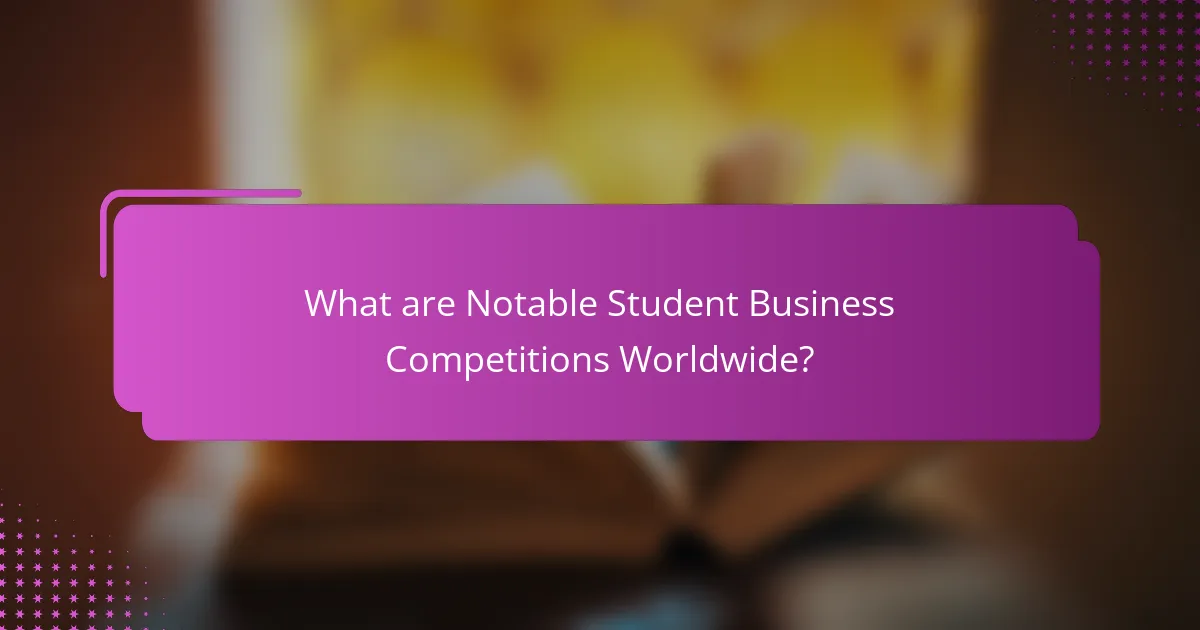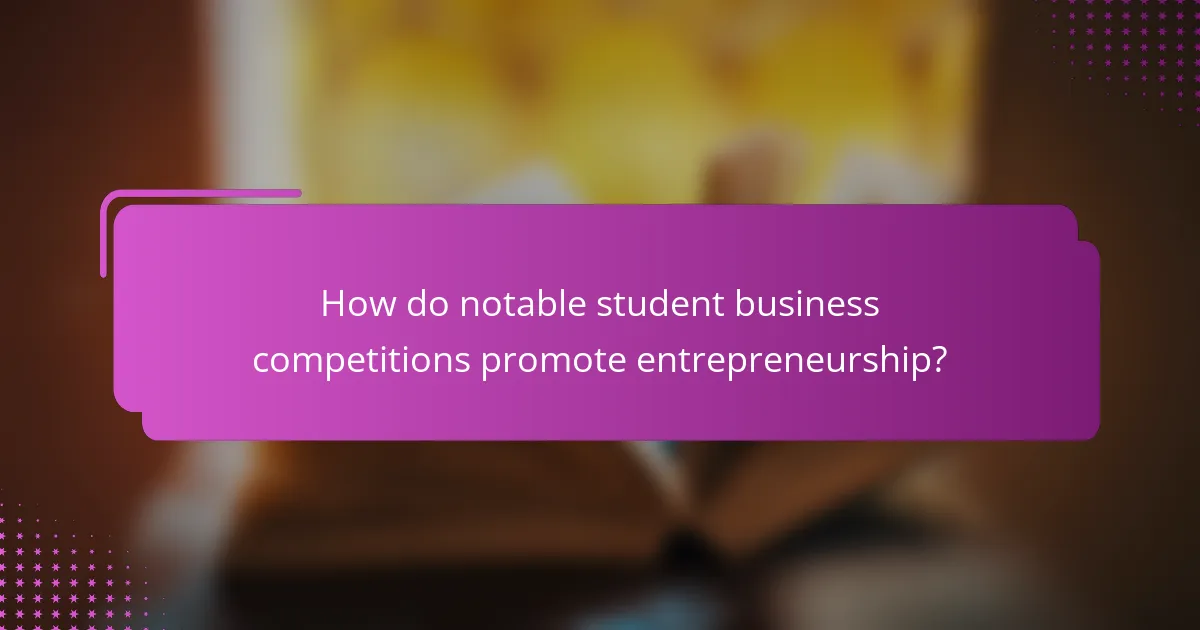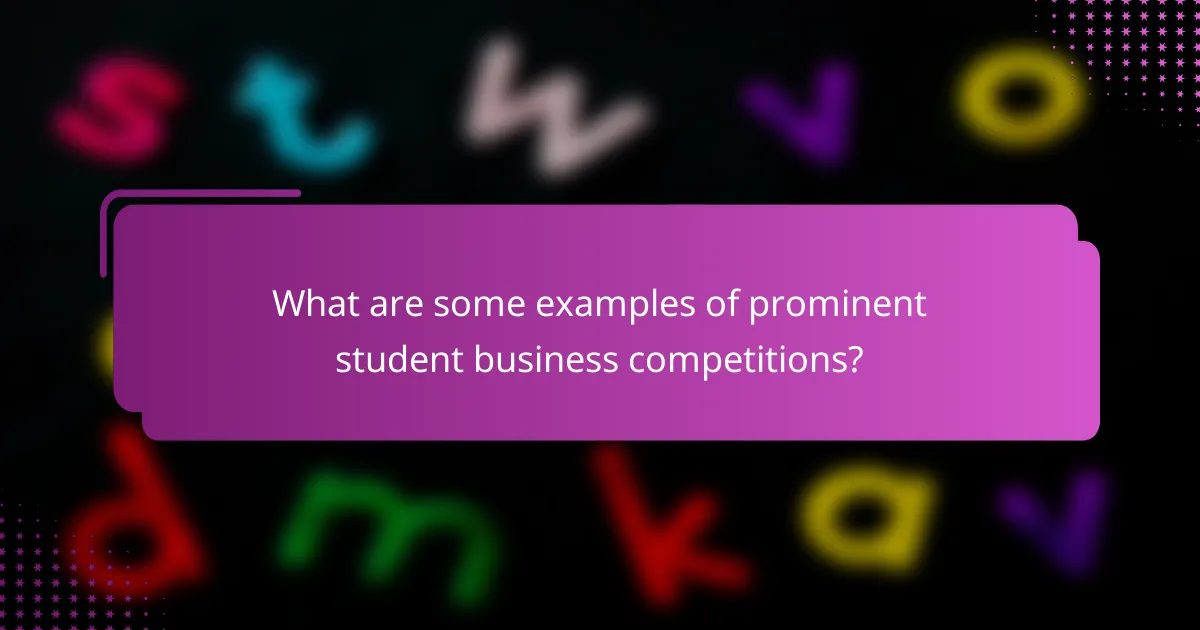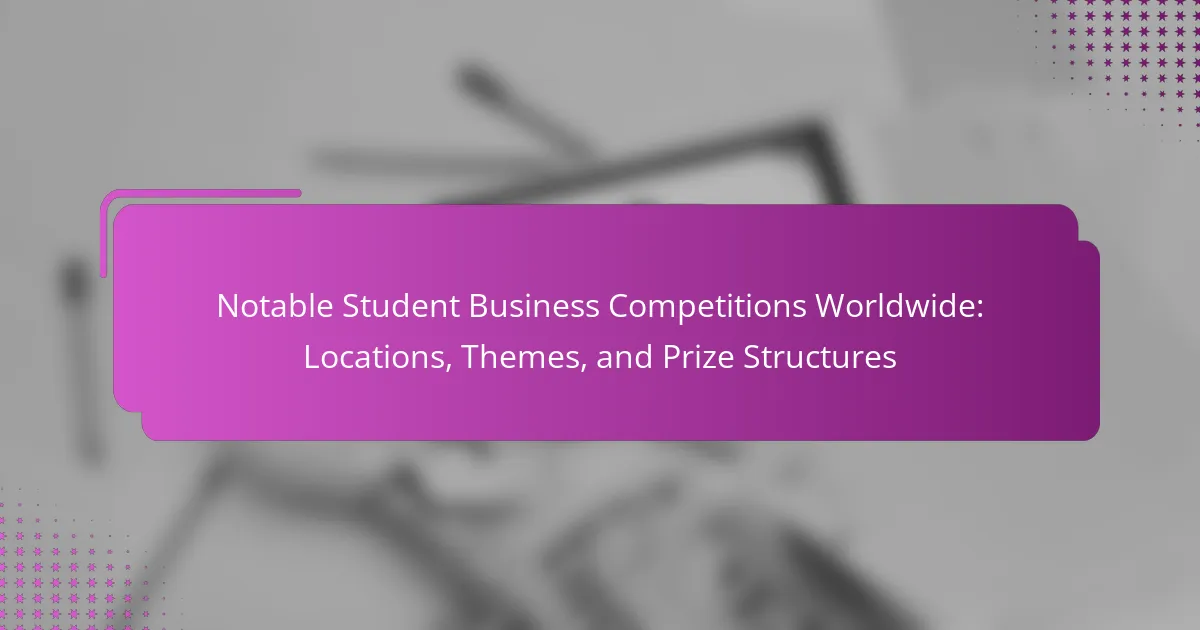Notable student business competitions worldwide, such as the Global Student Entrepreneur Awards, the Hult Prize, and the Enactus World Cup, play a crucial role in fostering entrepreneurship among students. These competitions provide platforms for students to showcase innovative business ideas and social entrepreneurship solutions, while also offering mentorship, networking opportunities, and potential funding. Participants develop essential skills in teamwork, leadership, and problem-solving, significantly enhancing their entrepreneurial capabilities. Additional competitions like the Collegiate Entrepreneurs’ Organization National Pitch Competition and the Harvard Business School New Venture Competition further contribute to this ecosystem by highlighting student-led initiatives with the potential for significant impact. The article will explore the locations, themes, and prize structures of these competitions, emphasizing their importance in shaping future entrepreneurs.

What are Notable Student Business Competitions Worldwide?
Notable student business competitions worldwide include the Global Student Entrepreneur Awards, the Hult Prize, and the Enactus World Cup. The Global Student Entrepreneur Awards is a prestigious competition that recognizes student entrepreneurs from around the globe. The Hult Prize challenges students to develop social entrepreneurship solutions to pressing global issues. The Enactus World Cup showcases student-led projects that create social and environmental impact. Other notable competitions are the Collegiate Entrepreneurs’ Organization (CEO) Pitch Competition and the Startup World Cup. These competitions provide students with opportunities to network, gain mentorship, and secure funding for their ventures. They often feature diverse themes and offer significant prize structures, encouraging innovation and entrepreneurship among students.
How do these competitions vary across different regions?
Competitions vary significantly across different regions in terms of themes, formats, and prize structures. In North America, competitions often emphasize entrepreneurship and innovation. They may include pitch contests and business plan competitions. In Europe, competitions frequently focus on sustainability and social impact. Many European contests encourage students to develop solutions for environmental challenges. In Asia, competitions often highlight technology and digital business models. Participants may be tasked with creating tech startups or apps.
Prize structures also differ; North American competitions may offer substantial funding, while European ones often provide mentorship opportunities. Asian competitions might include access to venture capital networks. Regional cultural values influence the types of businesses students are encouraged to develop. This diversity reflects the varying economic priorities and educational goals across regions.
What are the key characteristics of competitions in North America?
Competitions in North America are characterized by their focus on innovation and entrepreneurship. These events often encourage students to develop business plans and pitch ideas. Participants typically include university students from diverse disciplines. Competitions often feature significant monetary prizes and scholarships. Networking opportunities with industry professionals are common. Many competitions emphasize sustainability and social impact themes. Regional and national competitions often culminate in large-scale finals. The competitive landscape is supported by universities and corporate sponsors.
What unique features define competitions in Europe?
Competitions in Europe are characterized by a strong emphasis on innovation and sustainability. Many European competitions focus on addressing social and environmental challenges. For instance, the European Business Plan Competition promotes solutions for sustainable development. Additionally, these competitions often feature diverse themes, ranging from technology to social entrepreneurship. European competitions typically encourage collaboration across universities and industries. They also provide substantial financial incentives, with prizes often exceeding €10,000. Furthermore, participants frequently gain access to extensive mentorship and networking opportunities. This support helps students refine their business ideas and improve their chances of success.
How do Asian competitions differ from those in other continents?
Asian competitions often emphasize collaboration and community engagement more than those in other continents. Many Asian competitions encourage team-based projects. This fosters a spirit of cooperation among participants. In contrast, competitions in regions like North America often highlight individual achievement. Furthermore, Asian competitions frequently integrate local cultural elements into their themes. This reflects the diverse heritage of the region. For example, competitions in Asia may focus on sustainable development relevant to specific local challenges. In terms of prize structures, Asian competitions sometimes offer mentorship opportunities alongside monetary rewards. This contrasts with some Western competitions that prioritize cash prizes. Overall, the approach in Asia tends to be more holistic, blending educational outcomes with practical applications.
What themes are commonly explored in these competitions?
Common themes explored in notable student business competitions include entrepreneurship, innovation, and sustainability. Competitions often focus on developing new business ideas or products. They encourage participants to create solutions addressing real-world problems. Many competitions highlight social impact and community engagement. Others emphasize technology and digital transformation. Financial literacy and investment strategies are frequently examined as well. Market analysis and business strategy development are also common themes. These themes reflect current trends and challenges in the business landscape.
How do sustainability and social impact shape competition themes?
Sustainability and social impact significantly influence competition themes in student business competitions. These themes promote innovative solutions addressing environmental and social challenges. Competitions often encourage participants to develop sustainable business models. For instance, the Hult Prize focuses on social entrepreneurship and impact. Similarly, the Global Student Entrepreneur Awards emphasize business solutions that benefit society. Research shows that 70% of students prefer competitions with a sustainability focus. This trend reflects a growing awareness of global issues among young entrepreneurs. Thus, sustainability and social impact shape the direction and objectives of these competitions.
What role does technology play in the themes of student business competitions?
Technology plays a crucial role in student business competitions by enhancing innovation and accessibility. It enables participants to utilize digital tools for research, analysis, and presentation. Competitors often leverage software for financial modeling and market analysis. Online platforms facilitate collaboration among team members from different locations. Additionally, technology allows for virtual presentations, expanding participation to a global audience. Many competitions incorporate tech themes, encouraging participants to develop solutions for real-world problems. Data analytics tools help teams refine their strategies and improve outcomes. Overall, technology significantly influences the effectiveness and reach of these competitions.
How do cultural influences affect the themes of competitions in various countries?
Cultural influences significantly shape the themes of competitions in various countries. In Japan, competitions often emphasize harmony and group effort, reflecting collectivist values. This leads to themes centered around teamwork and collaboration. In contrast, American competitions frequently highlight individual achievement and innovation, mirroring a more individualistic culture. Themes in these competitions may focus on entrepreneurship and personal success.
In countries like India, competitions may incorporate traditional practices and local economic challenges. This results in themes that address social entrepreneurship and sustainable development. African competitions often reflect community-driven initiatives, focusing on local resources and cultural heritage. These themes encourage participants to develop solutions that resonate with their communities.
Research shows that cultural context influences motivation and participation in competitions. For example, a study by Hofstede highlights how cultural dimensions, such as power distance and uncertainty avoidance, affect competitive behavior. This demonstrates that cultural influences are critical in defining the themes and objectives of competitions worldwide.
What prize structures are typically associated with these competitions?
Prize structures in notable student business competitions typically include monetary awards, scholarships, and mentorship opportunities. Monetary awards can range from a few hundred to several thousand dollars. Scholarships may cover tuition fees or educational expenses for winners. Mentorship opportunities often connect winners with industry professionals to enhance their business skills. Additionally, some competitions offer resources such as office space or access to startup incubators. These structures incentivize participation and foster entrepreneurial growth among students. Competitions like the Global Student Entrepreneur Awards exemplify these prize structures, showcasing significant cash prizes and mentorship as key incentives.
What types of prizes are offered in student business competitions?
Student business competitions typically offer a variety of prizes. Common prizes include cash awards, scholarships, and internships. Many competitions also provide mentorship opportunities with industry professionals. Some offer access to startup funding or investment opportunities. Additionally, winners may receive resources like office space or business development services. Recognition through awards or certificates is also prevalent. These prizes aim to support students in their entrepreneurial endeavors and career development.
How do monetary awards compare to non-monetary prizes?
Monetary awards provide direct financial benefits, while non-monetary prizes offer recognition and opportunities. Monetary awards can be immediately utilized for expenses such as education or business ventures. According to a study by the National Bureau of Economic Research, cash prizes significantly motivate participants due to their tangible value. Non-monetary prizes often include mentorship, internships, or scholarships. These prizes can enhance skills and networking opportunities. Research indicates that non-monetary rewards can foster long-term engagement and satisfaction. Both types of awards serve different purposes and can appeal to varying motivations among participants.
What impact do prizes have on student participation and motivation?
Prizes significantly enhance student participation and motivation in competitions. They serve as tangible rewards that recognize effort and achievement. Research shows that students are more likely to engage in activities with the prospect of winning prizes. For instance, a study by Deci et al. (1999) found that external rewards can increase intrinsic motivation when they are perceived as a form of recognition. Additionally, prizes can create a competitive environment that encourages students to strive for excellence. This competitive spirit can lead to increased collaboration and networking among participants. Overall, prizes play a crucial role in incentivizing student involvement and fostering a motivated atmosphere in educational competitions.

How do notable student business competitions promote entrepreneurship?
Notable student business competitions promote entrepreneurship by providing practical experience and exposure to real-world business challenges. These competitions encourage students to develop innovative solutions and business plans. Participants gain valuable skills in teamwork, leadership, and problem-solving. Competitions often feature mentorship from industry experts, enhancing learning opportunities. They also foster networking with peers and professionals, which can lead to future collaborations. According to a study by the Kauffman Foundation, students involved in such competitions are more likely to pursue entrepreneurial ventures post-graduation. Additionally, prize structures often include funding or resources that support business startups, further incentivizing entrepreneurial pursuits.
What skills do participants gain from competing?
Participants gain various skills from competing in business competitions. These skills include teamwork, as participants often work in groups to achieve common goals. Communication skills are enhanced through presentations and pitches to judges. Critical thinking is developed as participants analyze problems and devise strategic solutions. Time management is crucial, as competitors must meet deadlines while balancing multiple tasks. Leadership skills are fostered when individuals take charge of projects or teams. Networking opportunities arise, allowing participants to connect with industry professionals. Financial literacy improves through budgeting and financial planning for business proposals. Adaptability is necessary, as competitors must respond to feedback and changing circumstances. These skills are valuable in both academic and professional settings.
How do competitions enhance networking opportunities for students?
Competitions enhance networking opportunities for students by providing platforms for interaction with peers, industry professionals, and potential employers. These events often attract participants from diverse backgrounds, fostering connections among students with similar interests. Networking occurs through team collaborations, mentorship programs, and industry-sponsored workshops. Many competitions feature judges and speakers from relevant industries, offering insights and connections. Research indicates that 70% of students find job opportunities through networking events, including competitions. This environment encourages students to build relationships that can lead to internships and job placements. Competitions also facilitate the exchange of ideas and experiences, further strengthening professional networks.
What role does mentorship play in the competition experience?
Mentorship plays a crucial role in the competition experience by providing guidance and support. Mentors offer valuable insights that enhance participants’ skills and strategies. They help competitors navigate challenges and make informed decisions. Additionally, mentorship fosters networking opportunities that can lead to future collaborations. Studies show that participants with mentors often achieve higher success rates. For example, a report by the National Mentoring Partnership indicates that mentored individuals are 55% more likely to enroll in college. This highlights the significant impact mentorship has on both personal and professional development during competitions.
What are the challenges faced by participants in these competitions?
Participants in notable student business competitions face several challenges. Time management is a significant issue, as participants must balance competition preparation with academic responsibilities. Limited resources can hinder participants, affecting their ability to conduct thorough market research or develop prototypes. Team dynamics often present challenges, as differing opinions can lead to conflicts. Additionally, participants may struggle with the pressure to perform, which can impact their decision-making abilities. Finally, competition rules and criteria can be complex, making it difficult for participants to understand expectations and deliver accordingly.
How do time constraints affect the performance of competitors?
Time constraints significantly impact the performance of competitors in business competitions. Limited time can lead to increased pressure and stress among participants. This stress often results in reduced decision-making quality. Competitors may rush through critical analysis and strategic planning. Consequently, their final presentations may lack depth and clarity. Research indicates that time pressure can impair cognitive functions, affecting creativity and problem-solving skills. For instance, a study published in the Journal of Experimental Psychology found that time constraints can hinder performance by limiting the ability to generate innovative solutions. Thus, while time constraints can motivate quick action, they often compromise the overall effectiveness of competitors.
What common obstacles do students encounter when preparing for competitions?
Students often encounter time management issues when preparing for competitions. Balancing academic responsibilities and competition preparation is challenging. Many students struggle to allocate sufficient time for practice and research. Additionally, inadequate access to resources can hinder preparation. Limited mentorship opportunities may also affect students’ readiness. Furthermore, stress and anxiety levels can increase during competition preparation. These emotional challenges can impact performance and focus. Lastly, lack of teamwork skills can lead to ineffective collaboration among peers.

What are some examples of prominent student business competitions?
Examples of prominent student business competitions include the Global Student Entrepreneur Awards, the Collegiate Entrepreneurs’ Organization National Pitch Competition, and the Harvard Business School New Venture Competition. The Global Student Entrepreneur Awards recognizes students who own and operate a business while attending college. The Collegiate Entrepreneurs’ Organization National Pitch Competition showcases innovative student startups. The Harvard Business School New Venture Competition focuses on new business ideas with potential for growth and impact. These competitions provide valuable experience and networking opportunities for participants.
What are the key features of the Global Student Entrepreneur Awards?
The Global Student Entrepreneur Awards (GSEA) focuses on recognizing student entrepreneurs worldwide. Key features include a global competition format that encourages participants from various countries. Participants must be enrolled in a college or university while running a business. The competition evaluates business plans, innovation, and social impact. Finalists receive mentorship and networking opportunities with industry leaders. The event culminates in a global finals competition, where winners receive cash prizes and other resources to support their ventures. GSEA promotes entrepreneurship education and fosters a community of young business leaders.
What distinguishes the Hult Prize from other competitions?
The Hult Prize is distinguished by its focus on social entrepreneurship. It specifically challenges students to develop innovative solutions to pressing global issues. Each year, the competition centers around a unique theme related to social impact. This theme guides participants in creating sustainable business models. Additionally, the Hult Prize offers a substantial monetary prize of $1 million to the winning team. This funding supports the implementation of their proposed solution. The competition also emphasizes a collaborative approach, bringing together students from diverse backgrounds. This fosters a global network of young changemakers dedicated to social good.
How does the Startup World Cup differ in its approach?
The Startup World Cup differs in its approach by focusing on a global scale and offering substantial investment prizes. It connects startups with venture capitalists from around the world. This competition emphasizes not just innovation but also the potential for scalability. Participants pitch their ideas to a diverse panel of judges. The prize structure includes a $1 million investment for the winner. This financial incentive attracts high-quality startups. The competition also fosters international networking opportunities. Overall, its unique structure promotes global collaboration among entrepreneurs.
What can participants do to maximize their success in these competitions?
Participants can maximize their success in competitions by thoroughly researching the competition’s rules and criteria. Understanding the judging process is crucial. Participants should also develop a unique and innovative idea that stands out. Creating a well-structured business plan is essential for clarity and impact. Networking with mentors and previous participants can provide valuable insights. Practicing presentations enhances delivery and confidence. Engaging in mock competitions can help refine strategies and improve performance. Finally, seeking feedback from peers can lead to improvements and increase chances of success.
How can effective team dynamics improve competition outcomes?
Effective team dynamics can significantly enhance competition outcomes. Strong collaboration fosters communication and trust among team members. This leads to more innovative ideas and effective problem-solving. Research shows that teams with high cohesion perform better under pressure. For instance, a study by Hackman and Oldham found that cohesive teams achieve higher performance levels. Additionally, effective dynamics encourage accountability, ensuring that all members contribute their strengths. This balanced participation can lead to improved decision-making. Ultimately, these factors combine to create a competitive edge in business competitions.
What strategies should students adopt for effective pitch presentations?
Students should adopt clear organization and engaging storytelling for effective pitch presentations. A well-structured pitch includes a strong opening, a clear problem statement, and a compelling solution. Visual aids enhance understanding and retention. Practicing delivery improves confidence and timing. Tailoring content to the audience increases relevance and impact. Feedback from peers can refine the presentation further. Research shows that organized pitches lead to higher success rates in competitions. According to a study by Harvard Business School, well-practiced presentations can increase persuasiveness by up to 20%.
Notable student business competitions worldwide serve as platforms for aspiring entrepreneurs to showcase their ideas and innovations. Key competitions include the Global Student Entrepreneur Awards, the Hult Prize, and the Enactus World Cup, each emphasizing different themes such as social impact and sustainability. The article explores regional variations in competition formats, prize structures, and cultural influences, highlighting how these factors shape participant experiences. Additionally, it addresses the skills gained through competition involvement, the importance of mentorship, and strategies for maximizing success.
